Terrorism is one of the gravest menaces facing our 21st-century world because it sees acts of violence as the only way to achieve political aims. The particular aim or problem depends on the terrorist's individual worldview. According to the terrorist's perverted outlook, political dilemmas and conflicts caused by ethnic and cultural differences can only be resolved by violence. No group can get what it wants, except by "blood and iron".
The terrorists believe that their objectives—enforcing their demands, spreading their organization's propaganda-can be attained only by damaging the fabric of society; when unease, fear and conflict come to dominate daily life. Some groups aim to take advantage of the climate of disorder that their actions bring about. They think that it will be easier to achieve their aims when social stability has collapsed and individuals are wracked with fear and uncertainty. From the disorder, they claim, will rise what they call "righteousness and justice." But expecting that acts of terrorism can establish righteousness and justice, or that problems can be resolved by violence, is a terrible mistake. Violence is counter-productive: All they that live by the sword shall perish by the sword.
In the Qur'an Allah describes such people as "those [who] cause corruption in the earth." (Surat ar-Ra'd: 25)y, So far, they have managed only to increase the number of deaths among the innocent, and among their own supporters as well. Every year, terrorist attacks cause thousands to live in fear and anxiety and suffer economic harm, not to mention those who are wounded or killed. Terrorism threatens all of mankind, its toll so very terrible that fighting it has become urgently essential.
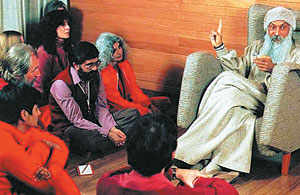 |
Bhagwan Shee Rajneesh, leader of a perverted cult that poisoned 750 people in Oregon, here seen with his followers. |
There are an estimated 500 terrorist groups in the world. These include international cartels controlling trade in drugs, arms and prostitution, as well as underground organizations, marginal movements, various radical ideological groups and deviant cults that stage actions allegedly in the name of religion. Many terrorist organizations do operate within their own countries' borders, but a number target what they have decided are "enemy" countries, through attacks on prominent sites and individuals that, they calculate, will elicit a huge public reaction. From the reaction, they seek to achieve fame, in fact notoriety, which they hope that will add to their power.
Though terrorism has existed since the earliest times, through esoteric organizations like the Sicarii or Assassins, and flourished in the modern times through revolutionary bodies such as the sans-culottes of the French Revolution or the Russian nihilism of the 19th century, its threat really came to the fore in the 20th century, which saw an explosion in acts of terror and in the number of terrorists who committed them. Weapons of mass destruction and the rapid advance of technology made terrorist attacks much easier and vastly increased their destructiveness.
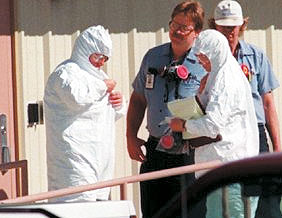 |
The Oregon attack was an important sign of the threat posed by terrorist groups who possess biological weapons. |
By the 1960s, people began to seriously wonder what might happen if a terrorist group managed to acquire some kind of nuclear weapon that could result in the deaths of tens of thousands. A biological or chemical attack could wipe entire populations off the map. No such attack happened, fortunately. But by the 1990s, the opportunities of such attacks increased. These concerns only heightened with the collapse of the Soviet Union and the weakening of control over its nuclear arsenal. The development of the internet and the facilitation of all forms of information increased these worries still further.1 Fear of terrorism became the subject of hundreds of films and books. Reports were written about the possible consequences and much research was carried out. Now, all too obviously, terrorists could go beyond familiar, limited actions like bombings, armed robberies, skyjackings and kidnappings, to attack entire communities. Such attacks could be carried out by remote control or computer, with no direct human intervention.
A number of recent fears in the US involving biological weapons like the anthrax bacterium revealed the scale of the threat posed by bio-terrorism and biological weapons. With the help of an experienced chemist in a simple laboratory, terrorists can now threaten the lives of thousands. One of the first examples of this occurred in 1984, when 750 people were poisoned in four restaurants in a small town in Oregon.2
Later, it was revealed that a Hindu-inspired New Age cult under the leadership of Baghwan Shree Rajneesh was responsible. Disciples had grown salmonella bacteria on their farms and placed them in salad bars in area restaurants. In 1995, the Aum Shinrikyo ("Higher Truth") cult released the poison gas sarin in the Tokyo underground subway system, leading to the deaths of 12 people and another 5,500 being injured. Subsequent inquiries revealed that the cult had tried to construct biological weapons in its own laboratories, revealing just how severe a threat terrorism poses to the public.3
 |
Aum Shinrikyo |
In the 21st century, computer technology is expected to play an important role in terrorist attacks. Meanwhile, more "conventional" forms of terrorism, like bombings, arson attacks, skyjackings and kidnappings are still going on all over the world, from Europe to America, from Asia to Africa. Since 1962, for example, members of the ETA (Euskadi Ta Askatasuna) terrorist organization, fighting for independence for the Basque region of Spain, has carried out many terrorist attacks in the country, resulting in the deaths of more than 800.4
For years, the Irish Republican Army seized world headlines with its bloody attacks intended to gain independence for Northern Ireland. The central aim of the IRA was to end British control of Northern Ireland and to achieve the reunification of the island of Ireland. It generally operated in Northern Ireland and London, but was also involved in bombings in various European countries, such as Germany. Since 1969, IRA terrorist attacks and Britain's methods of "counter-terrorism" caused the deaths of more than 3,200 on both sides of the conflict.5 Millions of dollars' worth of damage was caused by IRA bombings of airports and underground stations, again aimed at civilians. During a European Football Championship match on June 15, 1996, an IRA car bombing in a Manchester shopping center resulted in some 200 injuries.
Currently, no country can feel safe from this kind of threat. The few examples just cited show just how deeply terrorism has come to influence people's lives. No longer the problem of just a few specific nations, it is a threat that faces all mankind. Because no one can tell when, where or how terrorists will strike, the fight against them can no longer be considered the duty of a handful of countries or organizations. Terrorism, threatening the entire world, can be resolved only if well-intentioned people support each other in search of peace, friendship and brotherhood.
 |
On August 10, 2001, more than 250 died in an attack on a train by UNITA guerrillas fighting for Angolan independence. |
Terrorism is currently inflicting suffering and physical damage all over the world, not only in the United States, but in the African countries of Uganda, Angola and Nigeria; in the European nations of Great Britain, France and Spain; in Asian countries like Japan, and throughout the Middle East and Latin America. At any moment, civilians can find themselves facing a terrorist attack, whether sitting at home or at a movie theater, in a shopping center, riding a bus or at their workplace. Naturally, terrorism's ability to enter people's homes has led to considerable anxiety and alarm. People are hesitant to enter crowded areas or use public transport, and their daily lives are becoming intolerable. But that is exactly what terrorism wants to see, whole communities living in fear and alarm.
The evidence from terrible attacks throughout the world certainly confirms that concern. In 1996, there were 296 incidents with 314 people killed and 2,912 injured. In 1997, terrorism's scope began to expand. There were 439 attacks, 398 were aimed at workplaces or non-official premises, leading to the loss of 139 civilian lives, 39 of them civil servants or military personnel.6
According to the U.S. State Department, the number of terrorist attacks in 2000 saw an 8% rise over 1999, with 423 deaths and 791 injured. Between 1981 and 2000, the total number of deaths resulting from terrorist attacks was 9,184.7 These figures do not include all the people who died in all terrorist attacks across the globe. The report considered only attacks by international terrorist organizations, not those inflicted by local terrorist groups. In Turkey alone there were 21,866 terrorist attacks between August 15, 1984 and October 31, 2001, costing the lives of 5,605 security personnel and 4,646 civilians. A further 16,562 members of the security forces and 5,091 civilians were injured.8
The physical damage and economic harm resulting from terrorist actions add yet another sobering dimension to the picture. The disorder and anarchy provoked by such incidents prevents investment in the affected regions. Attacks aimed at the economic infrastructure does not just hold back development. Existing resources are also destroyed, creating economic difficulties that impede social life across a wide spectrum of areas, particularly education. Military costs of the struggle against terrorism impose yet another burden. This diversion of resources that should be spent on raising standards of living affects not just the nation in question, but the entire global economy.
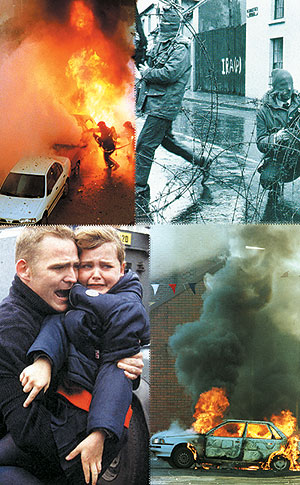 |
For years, the militants of the ETA and the IRA murdered many civilians and caused great physical damage in Spain and the UK. |
This summary reveals the grim picture that terrorism represents, bringing destruction all over the world and causing untold harm to people's lives.
The 1980s saw the end of Guzman's teaching career and the beginning of ongoing terrorism all over Peru. Like the Japanese kamikazes during World War II, Guzman and the Shining Path romanticized death. They believed it was a small price to pay for the rewards awaiting them beyond what Guzman called the "river of blood." Many innocent civilians were abducted, raped, tortured and killed; over one percent of the population died brutal deaths related to political violence. To further their cause, Guzman--then commonly known as "President Gonzalo"--and his Shining Path sought out and killed people of especially modest means, including teachers, mayors and civic leaders.10
World-Wide Terrorism Events | |||
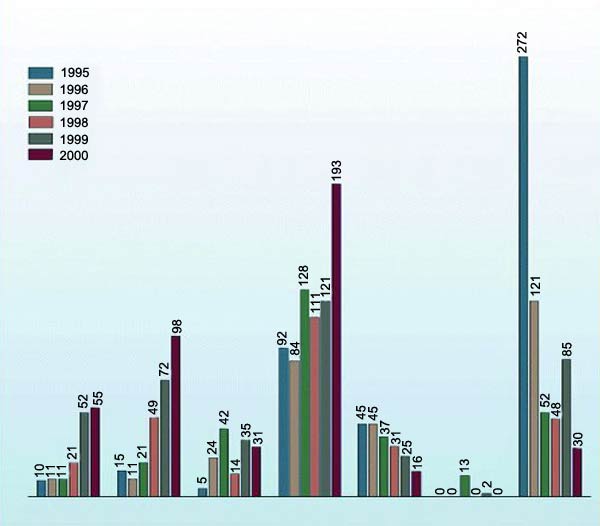 | |||
1. Africa | 3. Eurasia | 5. Middle East | 7. Western Europe |
Terrorism Events Between 1981-2000 |
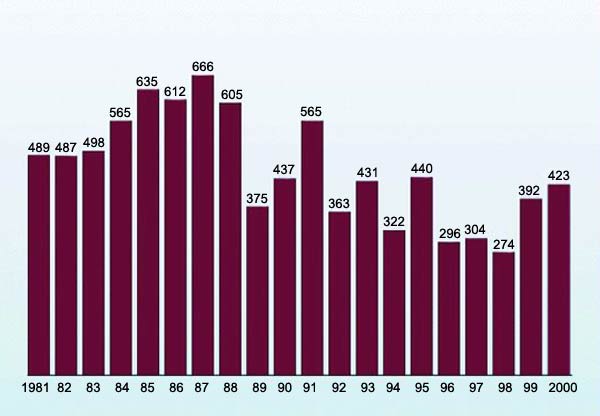 |
Graphs prepared by the U.S. State Department. The top one shows the regional distribution of terrorist incidents between 1995 and 2000. The bottom graph gives the chronological distribution of such incidents from 1981 through 2000. |
For years, the Shining Path inflicted physical and psychological damage, forcing the Peruvian public to live in fear That is a natural consequence of terrorism and, as will be emphasized throughout this book, love is the only way of defeating its root causes. Such a love for humanity will overcome the blind hatred and political necrophilia that terrorism is fed from.
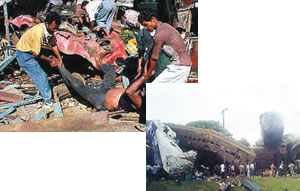 |
On August 30, 1996, 300 people died when a bomb exploded on a train in the Assam region of India. The attack is believed to have been carried out by separatist Bodo guerrillas. |
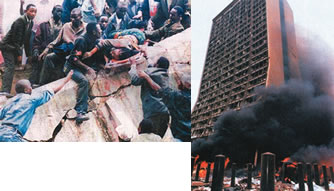 |
As a result of bomb explosions at the U.S. embassies in Kenya and Tanzania on August 7, 1998, 224 people were killed and hundreds were injured. 10 |
 |
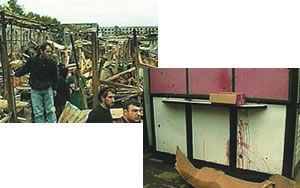 |
On October 21, 1999, a rocket attack on a crowded shopping center in the Chechen capital of Grozny resulted in 110 deaths and 400 injuries. |
THE BLOODY TERROR OF THE SHINING PATH |
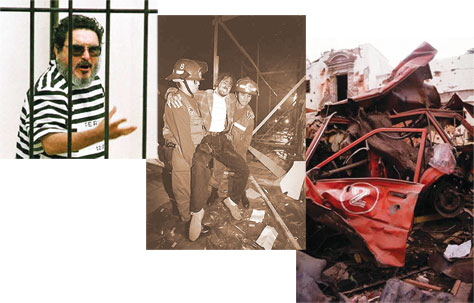 |
Peru's Shining Path, a Maoist terrorist organization, caused the deaths of more than 30,000. The picture at top right shows Abimeal Guzman, the organization's leader. |
This Marxist-Leninist-Maoist guerrilla group operates in Peru. Founded in the 1960s by Abimael Guzman, a professor of philosophy, the organization was originally regarded as just another political movement. In the 1970s, however, the Shining Path turned into a savage guerrilla group that is now one of the bloodiest terrorist organizations in the world. Guzman's statements in support of violence are particularly striking. In an April 19, 1980 address, the Shining Path's leader declared, "The future lies in guns and cannons."9 One of his guerrilla followers praised the use of violence: "Blood makes us stronger ... and if it is flowing, it is not harming us, but giving us strength." The organization openly stated that its struggle was built on the use of violence and debated how this could be increased in Peru. As a result, some 30,000 Peruvians were killed in the conflict. |
1. Vladimir Orlov, Anton Khlophov, Nezavissimaia Gazeta, Moskova, Le Courrier International, No: 571, 11-17 October 2001, pp. 99-100
2. Asli Zülal, Biyolojik Silahlar, (Biological Weapons), Bilim ve Teknik, no. 407, October 2001, p.44
3. Asli Zülal, Biyolojik Silahlar, (Biological Weapons), Bilim ve Teknik, no. 407, October 2001, p.44
4. http://www.terrorismfiles.org/organisations/basque_fatherland_and_liberty.html
5. http://www.terrorismanswers.com/groups/ira.html
6. http://www.cia.gov/cia/di/products/terrorism/index.html
7. Patterns of Global Terrorism 2000, Department of State Publication Office, Nisan 2001,
http://www.usis.usemb.se/terror/rpt2000/yearinreview.html
8. http://www.teror.gen.tr/turkce/rakamlarla/index.html
9. http://www.worldtrek.org/odyssey/latinamerica/050899/050899team.html (emphasis added)
10. http://www.worldtrek.org/odyssey/latinamerica/050899/050899team.html